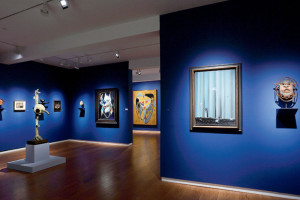
Watching the Surrealists at Work
An article in Art in America foregrounds how the works on show at Moon Dancers: Yup’ik Masks and the Surrealists might have actively influenced Surrealist thought and practice
late 19th/early 20th century
wood, paint, feathers, vegetal fibres, sinew
height: 31"
width: 18"
Inventory # CE4297
Please contact the gallery for more information.
Collected by schoolteachers Ralph and Anna Sullivan, stationed in Hooper Bay and Pilot Station, Alaska, between 1916 and 1918. The Sullivans collected a group of complex Yup’ik masks during their stay in Alaska, eight of which are now in the collection of the Glenbow Museum, Calgary, Alberta
George Terasaki, New York, NY
Donald Ellis Gallery, Dundas, ON
Private collection, New York, NY
"Moon Dancers: Yup'ik Masks and the Surrealists", Di Donna Galleries, New York, April 27 - June 29, 2018
The Face of Dance, Yup'ik Eskimo Masks From Alaska, Glenbow Museum, 1990, pg. 30, pl. X
Donald Ellis Gallery catalogue, 1997, front cover
Brasser, Ted. J. Native American Clothing: An Illustrated History. Toronto: Firefly Books, 2009, pg. 346
Art of the Arctic: Reflections of the Unseen (Masks), Ellis, London, Black Dog Publishing, 2015, pg. 25, pl. 3
Moon Dancers: Yup'ik Masks and the Surrealists, Field, Jennifer (Ed.), Di Donna Galleries, New York, 2018, pgs 108-109, 141
The Glenbow Museum, Calgary, AB – See: Ager Wallen, Lynn. The Face of Dance: Yup’ik Eskimo Masks From Alaska. Calgary: The Glenbow Museum, 1990, I-V for a group of complex masks also collected by Ralph and Anna Sullivan at Hooper Bay, Alaska
The Metropolitan Museum of Art (The Charles and Valerie Diker collection), New York – See: Ellis, Donald. Art of the Arctic: Reflections of the Unseen (Masks). London: Black Dog Publishing, 2015
Alaska State Museum, Nos. IIA5393 and IIA5404 (The Millote Collection) - See: Fienup-Riordan, Ann. The Living Tradition of Yup'ik Masks. Seattle: University of Washington Press, 1996, pgs. 291 and 293 for two later masks of similar form carved at Hooper Bay in the 1940s.
Yup’ik masks like the extraordinary example illustrated here were performed during winter ceremonials. According to Yup’ik belief, humans and animals share a common spirit or soul known as yua. During certain festivals the yua of animals and powerful spirits known as tuunrat were invited to the qasgiq (the mens ceremonial house), and were honoured with song and dance. Masked dancers acted as a conduit between the physical and the spirit world. These elaborate dances were performed to ensure the benevolence of spirits and to bring abundance to the participants and others in the village.
The present mask epitomises the Yup’ik belief in the inter-connectivity of all life past and present. Depending on the angle of viewing, the overall design represents a sea mammal and a bird. Two additional faces emerge from the surface, one carved and painted with hybrid human and zoomorphic features, the other appearing more heavily stylised, likely the face of a seal. Such shapeshifting suggests that the mask represents an animal yua, who could shift their physical appearance and even take on the form of a human being. This interpretation is further supported by two hands protruding from either side of the mask. Plume feathers and a number of carved fish appendages add striking visual complexity, while a single hoop bent around the entire composition likely represents the Yup’ik universe. At the top end of the mask hovers a small human figure.

An article in Art in America foregrounds how the works on show at Moon Dancers: Yup’ik Masks and the Surrealists might have actively influenced Surrealist thought and practice

State of the Arts NYC writes that Moon Dancers: Yupik Masks and the Surrealists celebrates the ‘remarkable connections between Surrealism and Yup’ik masks’

$25.00 USD